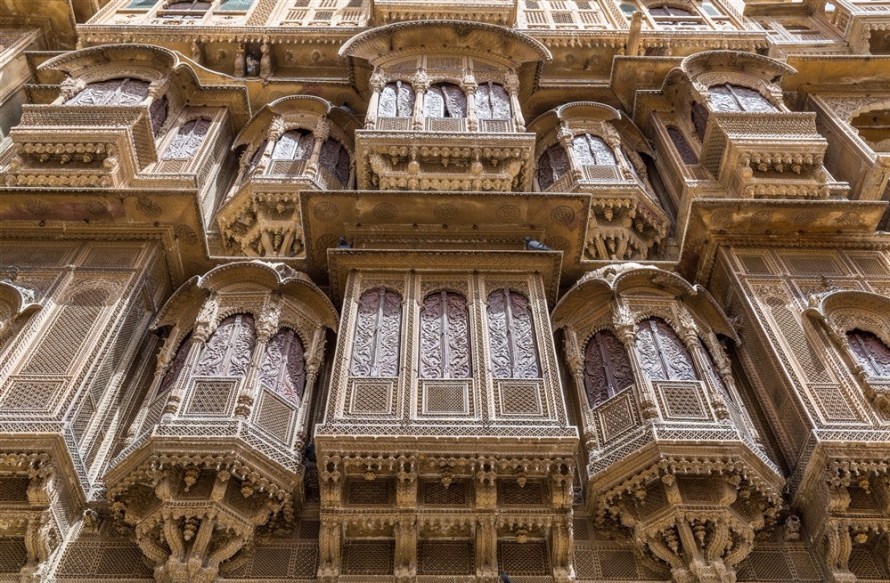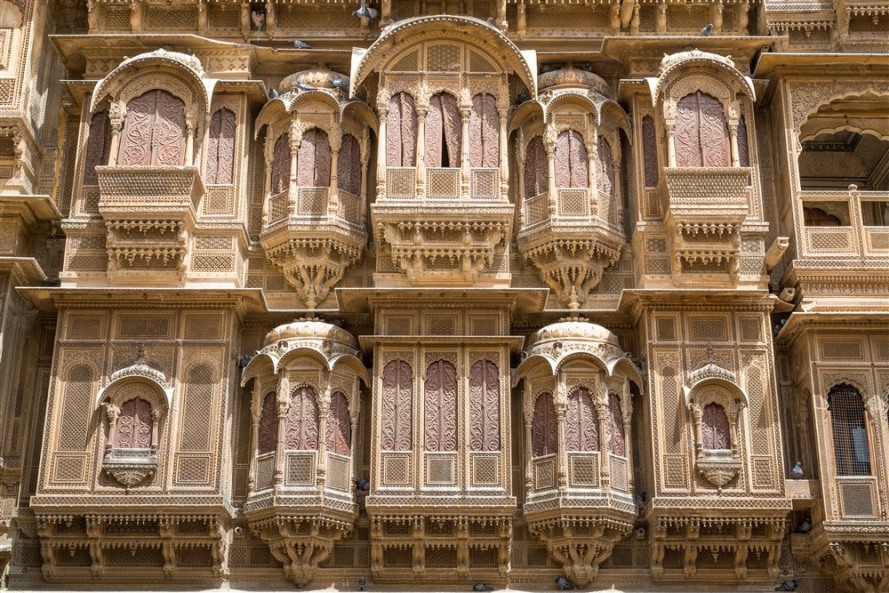An architectural wonder of the bygone era, Patwon Ki Haveli is one of the main attractions that one can look for in the city of Jaisalmer. The Patwon Ki Haveli is a cluster of five small Havelis, the exteriors of which are dipped in an enchanting shade of gold.
The history of this magnificent structure dates back to the 18th century. Once the residence of rich traders of Jaisalmer Patwas, the Haveli was constructed in the span of fifty years by Guman Chand Patwa and his five sons. A true specimen of Rajputana sculpture, the Patwon Ki Haveli is famous for its exclusive mirror work and fine wall paintings.

Amongst the five Havelis which form the entire complex, one has been converted into a museum that displays a vast collection of antique furniture and decorative goods. Besides this, the third Haveli or mansion in the premises also houses rich items that include traditional art and craftwork of the local craftsmen.
The Patwon Ji ki Haveli is an interesting piece of Architecture and is the most important among the Havelis in Jaisalmer. This is precise because of two things, first that it was the first haveli erected in Jaisalmer and second, that it is not a single haveli but a cluster of 5 small Havelis. The first among these Havelis was commissioned and constructed in the year 1805 by Guman Chand Patwa and is the biggest and the most ostentatious.

Architecture has always demonstrated a pivotal part of India’s tourism. A special position is to hold in terms of architecture which proves Rajasthan a top-notch place of tourism. Often known by the name “The city of Gold” Jaisalmer is a place of palaces forts and Havelis. Many tourist places attract tourists worldwide to witness the range of architectural brilliance.
After Jaisalmer fort, Patwon ki Haveli is the most visited place in Jaisalmer. Patwa Haveli is a treat to the eyes of an interesting piece of architecture. The minute detailing of architecture awestruck every tourist.
Patwon ki haveli has two main reasons to term as an interesting piece of Jaisalmer. Firstly, it was the first haveli which withstood in Jaisalmer and Secondly, it is not one single haveli but an agglomeration of 5 Havelis.
It is believed that Patwa was a rich man and was a renowned trader of his time. He could afford and thus ordered the construction of separate stories for each of his 5 sons. These were completed in the span of 50 years. All five houses were constructed in the first 60 years of the 19th century.
The Havelis are also known as the ‘mansion of brocade merchants’. This name has been given probably because the family dealt in threads of gold and silver used in embroidering dresses. However, there are theories, which claim that these traders made a considerable amount of money in Opium smuggling and Money-lending. This is the largest Haveli in Jaisalmer and stands in a narrow lane.
History of Patwon-ki-Haveli
This haveli is presently occupied by the government, which uses it for various purposes. The office of the Archeological Survey of India and State art and craft department is situated in the haveli itself.
The year 1805 marked the establishment of the haveli by Guman Chand Patwa. Guman Chand Patwa was a renowned trader at his time and perhaps the reason he constructed five different stories for his sons. It took 50 long years to construct a huge mansion.
As the family dealt with thread word of gold and silver the Haveli is also known by the name mansion of brocade merchant.
Nevertheless, even after these encroachments and abuse, you can find a good amount of paintings and mirror-works on the wall. The other important aspects are its gateways and arches. You will notice individual depictions and themes on each and every arch. Although the whole building is made of yellow sandstone, the main gateway of the Patwon Ji ki Haveli is in brown colour.

The use of yellow sandstone has made it a glamorous haveli. Furthermore, the brown gateways and walls with the minute mirror work have beautified even more. Paintings on the walls and arches with unique style gives a distinctive feature. Moreover, the jali works or cravings illuminate the palace even more. The mansion has 60 balconies where it reflects the traditional art of Jaisalmer very well.
At present, the haveli is occupied by the government of India. The government of India used the Haveli for various purposes. The Haveli consists of the Archeological Survey of India and the State art and craft office. A part of the Haveli displays paintings, artefacts, crafts, etc. displaying the lavish lifestyle enjoyed.
As for going inside the Haveli, you actually have two choices out of the five – but confusingly they both seem to have the same name. The huge mansion suddenly emerges out of nowhere dwarfing all other houses around it. The sight of its breathtaking architecture and impressive carvings on the outer walls will leave you choking with appreciation. Huge corridors, lined with beautifully designed pillars all along will slow your pace as you tour the haveli.
Tags: Five small Havelis, Traditional Art, Architectural Brilliance. Yellow Sandstone.

